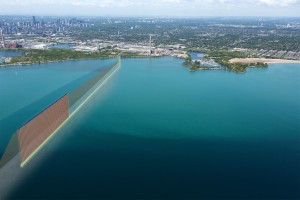
Toronto sewage outfall in Lake Ontario will be largest in Canada
October 20, 2015
By
CCE

Conceptual isometric rendering for the planned Ashbridges Bay Treatment Plant Outfall off Toronto. Yellow lines represent the outfall shaft and tunnel; brown lines represent the riser pipes from the tunnel to the lake; blue components are the diffuser ports for discharging the treated effluent. Image: Hatch Mott MacDonald.
Hatch Mott MacDonald has been selected by the City of Toronto to provide detailed design and construction administration for a new tunnel outfall into Lake Ontario.
The outfall will release treated effluent form the Ashbridge’s Bay Wastewater Treatment plant in the Beach area east of downtown. It will be the largest wastewater outfall in Canada.
Replacing an older outfall, the outfall will convey up to 3,920 million litres per day in a tunnel that will be 3,500 metres long and 7 metres in internal diameter,. The tunnelling will be through rock beneath the lakebed. The project also includes a drop shaft and a connection to lakebed risers, which will be constructed by barge from the lake above.
Michael Schatz, HMM’s managing director for Canada, said: “The Ashbridges outfall project will draw on HMM’s strengths in tunnelling and in wastewater treatment. We are proud to have won several awards for our work on the Keswick Effluent Outfall in Lake Simcoe and we will bring the same care and expertise to this new challenge.”
Design and planning of the Toronto outfall will take until the end of 2017, with construction taking four years, between 2018-2022.